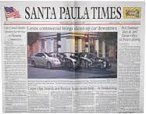Distracted Driving Month: Crackdown planned
for April for texting, cell phone use
April 01, 2015
By Peggy Kelly
Santa Paula News
Wednesday is April 1st but area police won’t be trying to fool anyone when they write a ticket for distracted driving, a month-long effort to make people pay more attention to the road.
Distracted driving is most broadly defined as driving while talking or texting on a cell phone: “People know it’s against the law, it’s not like we’re telling people anything new,” said Santa Paula Police Sgt. Jeremy Watson, the department’s Traffic Investigator.
“The law’s been out there for six or seven years now,” but people — especially young drivers — persist in breaking the law and putting their lives and the lives of others in danger.
“Silence the Distractions,” means to turn off cell phones that can cause a driver’s attention to wander.
“It’s Not Worth It!” is the motto of April’s Distracted Driving Awareness Month that Watson said law enforcement through the state will be enforcing, including the SPPD.
The campaign is to save lives and educate all Californians, especially young drivers, about the dangers of distracted driving. The California Office of Traffic Safety (OTS), California Highway Patrol (CHP), Impact Teen Drivers, and more than 200 law enforcement agencies statewide are working together on increased education and enforcement efforts for National Distracted Driving Awareness Month in April and California Teen Safe Driving Week, the first week of April.
“I put out an email to all our Santa Paula Officers that April is Distracted Drivers Month and they should watch for it and issue tickets to offenders,” said Watson.
In fact, for two days in April Watson said an officer would be assigned “Just to concentrate on distracted driving — and ticket those not obeying the law.”
That effort, he added, is going to be statewide with officers watching for distracted drivers on two high visibility enforcement days for all law enforcement agencies that are participating in the national traffic safety campaign.
That’s a lot of officers out there with ticket books watching for distracted drivers.
Some people don’t realize that “Driving takes one’s full attention and any distraction can have deadly, dangerous consequences … imagine driving for four or five seconds while blindfolded. That can be the effect of looking down to send a text message.”
And, Watson added, “In the average time it takes to check a text message — less than 5 seconds — a car traveling 60 mph will travel more than the length of a football field.”
It won’t be all tickets: throughout the month of April, police and sheriff departments as well as the California Highway Patrol will focus on educating the public about the dangers of driving distracted through media exposure, visits to schools, and traffic safety presentations.
In addition, to highlight how the urge to read and answer an incoming message when we hear the text sound can be almost overwhelming, the Office of Traffic Safety (OTS) is using a message of “Silence the Distraction” in new public service announcements aimed at getting drivers to turn off their phones while driving so they won’t be tempted.
“If you don’t hear it you can’t answer it and if it’s important someone will leave a message,” said Watson.
“No text, call, or social media update is worth a crash,” said OTS Director Rhonda Craft. “With an average of less than a second to react to an urgent situation, drivers need to have all their attention on the roadway.”
While distracted driving can take on many forms and affects all road users, young drivers are at a greater risk. During “California Teen Safe Driving Week,” April1-7, Impact Teen Drivers will focus on educating teens that their number one killer — reckless and distracted driving — is 100 percent preventable.
“People are realizing that everyday behaviors, such as texting or reaching for a dropped item, can be lethal when done behind the wheel,” Kelly Browning, Ph.D., Executive Director of Impact Teen Drivers, said.
Distracted driving is a dangerous epidemic on America’s roadways: in 2012 alone, 3,328 were killed in distracted driving crashes.
Although a National Highway Transportation Safety Administration estimated distraction to be a factor in only 14 percent of all teen crashes, the findings of a recent AAA study — which used cameras in 1,700 vehicles to record incidents — the rate is actually closer to a whopping 58 percent.
“Each of us,” said Watson, “must drive responsibly, keeping full attention to the task at hand - DRIVING. If you have teenagers in your family who are driving, make sure they understand the laws and what their responsibilities are as well.
“The collective goal with this month-long campaign is to change the behavior of all drivers,” and that change, said Watson, “begins with education.”
And remember: distracted driving is anything that takes attention away from safety, from grooming and eating to watching a video or checking a GPS.


